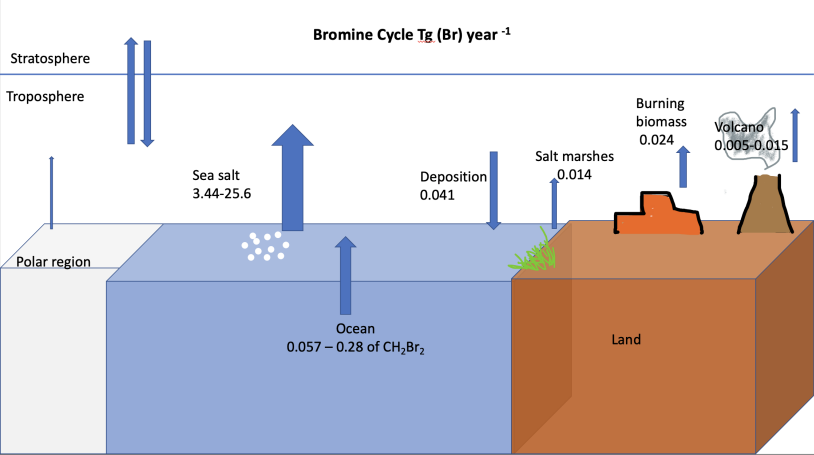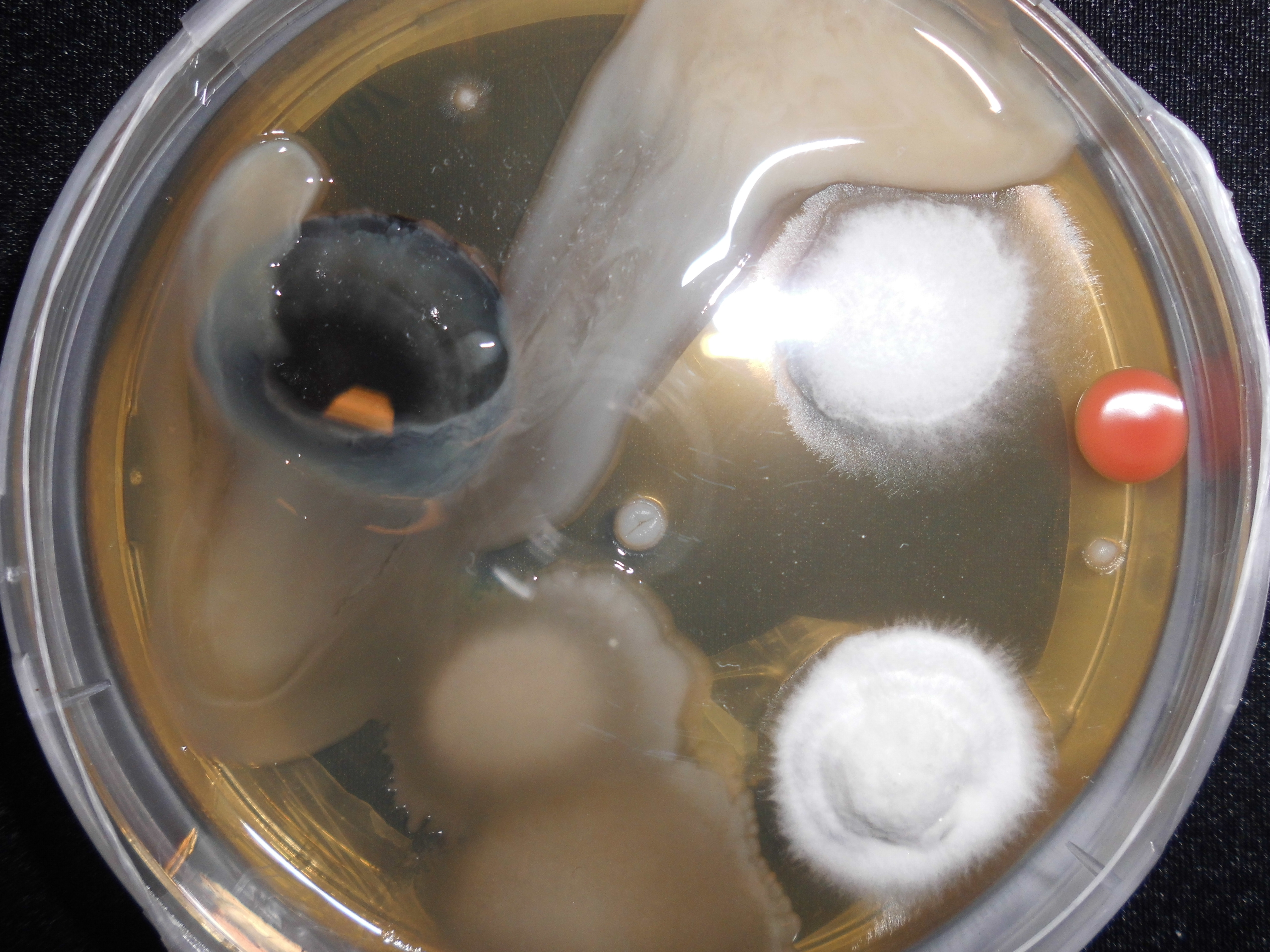|
Bromomethane
Bromomethane, commonly known as methyl bromide, is an organobromine compound with formula C H3 Br. This colorless, odorless, nonflammable gas is produced both industrially and biologically. It is a recognized ozone-depleting chemical. According to the IPCC Fifth Assessment Report, it has a global warming potential of 2. The compound was used extensively as a pesticide until being phased out by most countries in the early 2000s. From a chemistry perspective, it is one of the halomethanes. Occurrence and manufacture Marine organisms are estimated to produce 56,000 tonnes annually. It is also produced in small quantities by certain terrestrial plants, such as members of the family Brassicaceae. In 2009, an estimated 24,000 tonnes of methyl bromide were produced. Its production was curtailed by the Montreal Protocol, such that in 1983, production was nearly twice that of 2009 levels. It is manufactured by treating methanol with bromine in the presence of sulfur or hydrogen sulf ... [...More Info...] [...Related Items...] OR: [Wikipedia] [Google] [Baidu] |
Halomethane
Halomethane compounds are derivatives of methane () with one or more of the hydrogen atoms replaced with halogen atoms (Fluorine, F, Chlorine, Cl, Bromine, Br, or Iodine, I). Halomethanes are both naturally occurring, especially in marine environments, and human-made, most notably as refrigerants, solvents, propellants, and fumigants. Many, including the chlorofluorocarbons, have attracted wide attention because they become active when exposed to ultraviolet light found at high altitudes and destroy the Earth's protective ozone layer. Structure and properties Like methane itself, halomethanes are tetrahedral molecules. The halogen atoms differ greatly in size and charge from hydrogen and from each other. Consequently, most halomethanes deviate from the perfect tetrahedral symmetry of methane.Günter Siegemund, Werner Schwertfeger, Andrew Feiring, Bruce Smart, Fred Behr, Herward Vogel, Blaine McKusick “Fluorine Compounds, Organic” Ullmann's Encyclopedia of Industrial Chemistry, ... [...More Info...] [...Related Items...] OR: [Wikipedia] [Google] [Baidu] |
Bromine
Bromine is a chemical element; it has chemical symbol, symbol Br and atomic number 35. It is a volatile red-brown liquid at room temperature that evaporates readily to form a similarly coloured vapour. Its properties are intermediate between those of chlorine and iodine. Isolated independently by two chemists, Carl Jacob Löwig (in 1825) and Antoine Jérôme Balard (in 1826), its name was derived , referring to its sharp and pungent smell. Elemental bromine is very reactive and thus does not occur as a free element in nature. Instead, it can be isolated from colourless soluble crystalline mineral halide Ionic salt, salts analogous to table salt, a property it shares with the other halogens. While it is rather rare in the Earth's crust, the high solubility of the bromide ion (Br) has caused its Bromine cycle, accumulation in the oceans. Commercially the element is easily extracted from brine evaporation ponds, mostly in the United States and Israel. The mass of bromine in the oce ... [...More Info...] [...Related Items...] OR: [Wikipedia] [Google] [Baidu] |
Organobromine Compound
Organobromine chemistry is the study of the synthesis and properties of organobromine compounds, also called organobromides, which are organic compounds that contain carbon bonded to bromine. The most pervasive is the naturally produced bromomethane. One prominent application of synthetic organobromine compounds is the use of polybrominated diphenyl ethers as fire-retardants, and in fact fire-retardant manufacture is currently the major industrial use of the element bromine. A variety of minor organobromine compounds are found in nature, but none are biosynthesized or required by mammals. Organobromine compounds have fallen under increased scrutiny for their environmental impact. General properties Most organobromine compounds, like most organohalide compounds, are relatively nonpolar. Bromine is more electronegative than carbon (2.9 vs 2.5). Consequently, the carbon in a carbon–bromine bond is electrophilic, i.e. alkyl bromides are alkylating agents. Carbon–haloge ... [...More Info...] [...Related Items...] OR: [Wikipedia] [Google] [Baidu] |
Soil Steam Sterilization
Soil steam sterilization (soil steaming) is a farming technique that Sterilization (microbiology), sterilizes soil with steam in open fields or greenhouses. Pests of plant cultures such as weeds, bacteria, fungi and viruses are killed through induced hot steam which causes vital cellular proteins to Protein folding, unfold. Biologically, the method is considered a partial disinfection. Important heat-resistant, spore-forming bacteria can survive and revitalize the soil after cooling down. Soil fatigue can be cured through the release of nutritive substances blocked within the soil. Steaming leads to a better starting position, quicker growth and strengthened resistance against plant disease and pests. Today, the application of hot steam is considered the best and most effective way to disinfect sick soil, potting soil and compost. It is being used as an alternative to bromomethane, whose production and use was curtailed by the Montreal Protocol. "Steam effectively kills pathog ... [...More Info...] [...Related Items...] OR: [Wikipedia] [Google] [Baidu] |
Bromine Cycle
The bromine cycle is a biogeochemical cycle of bromine through the atmosphere, biosphere, and hydrosphere. Bromine has natural and anthropogenic sources, impacting each sphere as bromine is stored, released, or taken up. Ozone depletion and health hazards to humans, animals, and plants are effects of bromine throughout the environment. Sources Natural sources Bromine is present naturally as bromide salts in evaporite deposits. Bromine is also present in soils and marine algae that synthesize organic bromine compounds. Other natural sources of bromine come from polar ice and snow, salt lakes, and volcanoes. The primary natural source of bromine to the atmosphere is sea spray aerosols. Oceans contain small amounts of bromine due to waves perturbing gas bubbles containing bromine, as well as marine biota producing bromine containing compounds. The lifetime of bromine from sea spray aerosols is determined by the time it takes for photolysis to release bromine from sea spray aer ... [...More Info...] [...Related Items...] OR: [Wikipedia] [Google] [Baidu] |
Bromoiodomethane
Bromoiodomethane is a halomethane with the formula BrCH2I. It is a colorless liquid, although older samples appear yellow. The compound has been investigated as a reagent for cyclopropanation by the Simmons-Smith reaction, but diiodomethane and chloroiodomethane Chloroiodomethane is the halomethane with the formula is . It is a colorless liquid of use in organic synthesis. Together with other iodomethanes, chloroiodomethane is produced by some microorganisms. Applications Chloroiodomethane is used in cy ... are preferred. It also occurs naturally as the result of microbial action. Its critical point is at 367.85 °C and 6.3 MPa and refractive index is 1.6382 (20 °C, D). Additional reading * * * * References External linksUV Spectra data Halomethanes Bromoiodoalkanes {{Organohalide-stub ... [...More Info...] [...Related Items...] OR: [Wikipedia] [Google] [Baidu] |
Hydrogen
Hydrogen is a chemical element; it has chemical symbol, symbol H and atomic number 1. It is the lightest and abundance of the chemical elements, most abundant chemical element in the universe, constituting about 75% of all baryon, normal matter. Under standard conditions, hydrogen is a gas of diatomic molecules with the chemical formula, formula , called dihydrogen, or sometimes hydrogen gas, molecular hydrogen, or simply hydrogen. Dihydrogen is colorless, odorless, non-toxic, and highly combustible. Stars, including the Sun, mainly consist of hydrogen in a plasma state, while on Earth, hydrogen is found as the gas (dihydrogen) and in molecular forms, such as in water and organic compounds. The most common isotope of hydrogen (H) consists of one proton, one electron, and no neutrons. Hydrogen gas was first produced artificially in the 17th century by the reaction of acids with metals. Henry Cavendish, in 1766–1781, identified hydrogen gas as a distinct substance and discovere ... [...More Info...] [...Related Items...] OR: [Wikipedia] [Google] [Baidu] |
Sterilization (microbiology)
Sterilization () refers to any process that removes, kills, or deactivates all forms of life (particularly microorganisms such as fungi, bacteria, spores, and unicellular eukaryotic organisms) and other biological agents (such as prions or viruses) present in fluid or on a specific surface or object. Sterilization can be achieved through various means, including heat, chemicals, irradiation, high pressure food preservation, high pressure, and filtration. Sterilization is distinct from disinfection, sanitization, and pasteurization, in that those methods reduce rather than eliminate all forms of life and biological agents present. After sterilization, fluid or an object is referred to as being sterile or aseptic. Applications Foods One of the first steps toward modernized sterilization was made by Nicolas Appert, who discovered that application of heat over a suitable period of time slowed the decay of foods and various liquids, preserving them for safe consumption for a longer t ... [...More Info...] [...Related Items...] OR: [Wikipedia] [Google] [Baidu] |
Neostigmine Bromide
Neostigmine, sold under the brand name Bloxiverz, among others, is a medication used to treat myasthenia gravis, Ogilvie syndrome, and urinary retention without the presence of a blockage. It is also used in anaesthesia to end the effects of non-depolarising neuromuscular blocking medication. It is given by injection either into a vein, muscle, or under the skin. After injection effects are generally greatest within 30 minutes and last up to 4 hours. Common side effects include nausea, increased saliva, crampy abdominal pain, and slow heart rate. More severe side effects include low blood pressure, weakness, and allergic reactions. It is unclear if use in pregnancy is safe for the baby. Neostigmine is in the cholinergic family of medications. It works by blocking the action of acetylcholinesterase and therefore increases the levels of acetylcholine. Neostigmine was patented in 1931. It is on the World Health Organization's List of Essential Medicines. The term is from Gree ... [...More Info...] [...Related Items...] OR: [Wikipedia] [Google] [Baidu] |
Bermuda Grass
''Cynodon dactylon'', commonly known as Bermuda grass, also known as couch grass in Australia and New Zealand, is a grass found worldwide. It is native to Europe, Africa, Australia and much of Asia. It has been introduced to the Americas. Contrary to its common name, it is not native to Bermuda and is in fact an abundant invasive species there. In Bermuda it has been known as "crab grass" (also a name for ''Digitaria sanguinalis''). Other names are ''Dhoob'', ''dūrvā'' grass, ''ethana'' grass, ''dubo'', dog grass, dog's tooth grass, Bahama grass, crab grass, devil's grass, couch grass, Indian ''doab'', ''arugampul'', grama, wiregrass and scutch grass. Hybrid species of Cynodon dactylon have been produced known as Cynodon dactylon x transvaalensis. These are Interspecific hybrids from cross-pollination of plants of different species. Vegetatively propagated Bermuda/couch hybrid varieties are developed by a selection of superior plants from established seeded or vegetatively prop ... [...More Info...] [...Related Items...] OR: [Wikipedia] [Google] [Baidu] |
ISPM 15
International Standards For Phytosanitary Measures No. 15 (ISPM 15) is an International Phytosanitary Measure developed by the International Plant Protection Convention (IPPC) that directly addresses the need to treat wood materials of a thickness greater than 6mm, used to ship products between countries. Its main purpose is to prevent the international transport and spread of disease and insects that could negatively affect plants or ecosystems. ISPM 15 affects all wood packaging material (pallets, crates, dunnages, etc.) and requires that they be debarked and then heat treated or fumigated with methyl bromide, and stamped or branded with a mark of compliance. This mark of compliance is colloquially known as the "wheat stamp". Products exempt from the ISPM 15 are made from an alternative material, like paper, plastic or wood panel products (i.e. OSB, hardboard, and plywood). ISPM 15 revision The Revision of ISPM No. 15 (2009) under Annex 1, requires that wood used to manufact ... [...More Info...] [...Related Items...] OR: [Wikipedia] [Google] [Baidu] |






